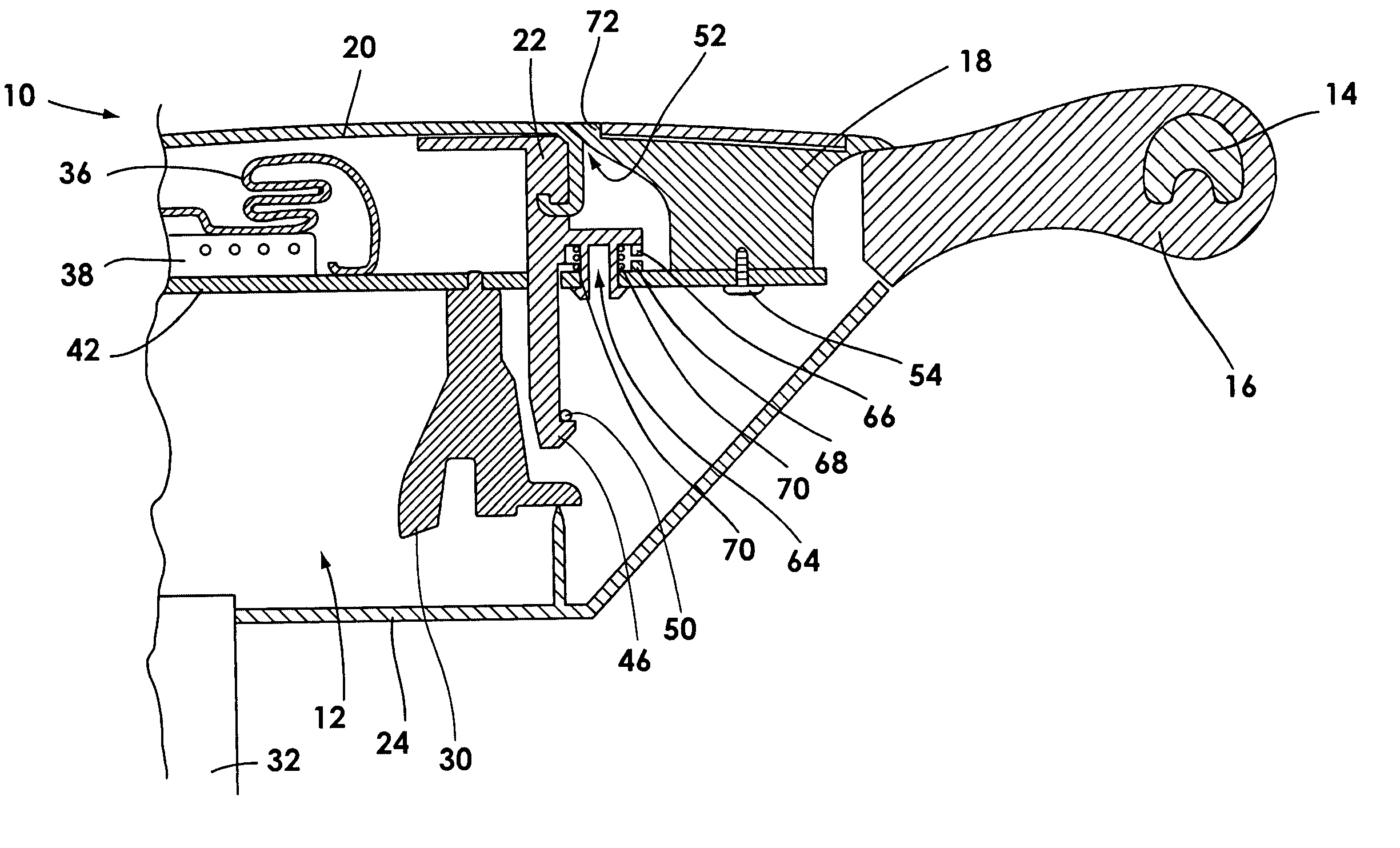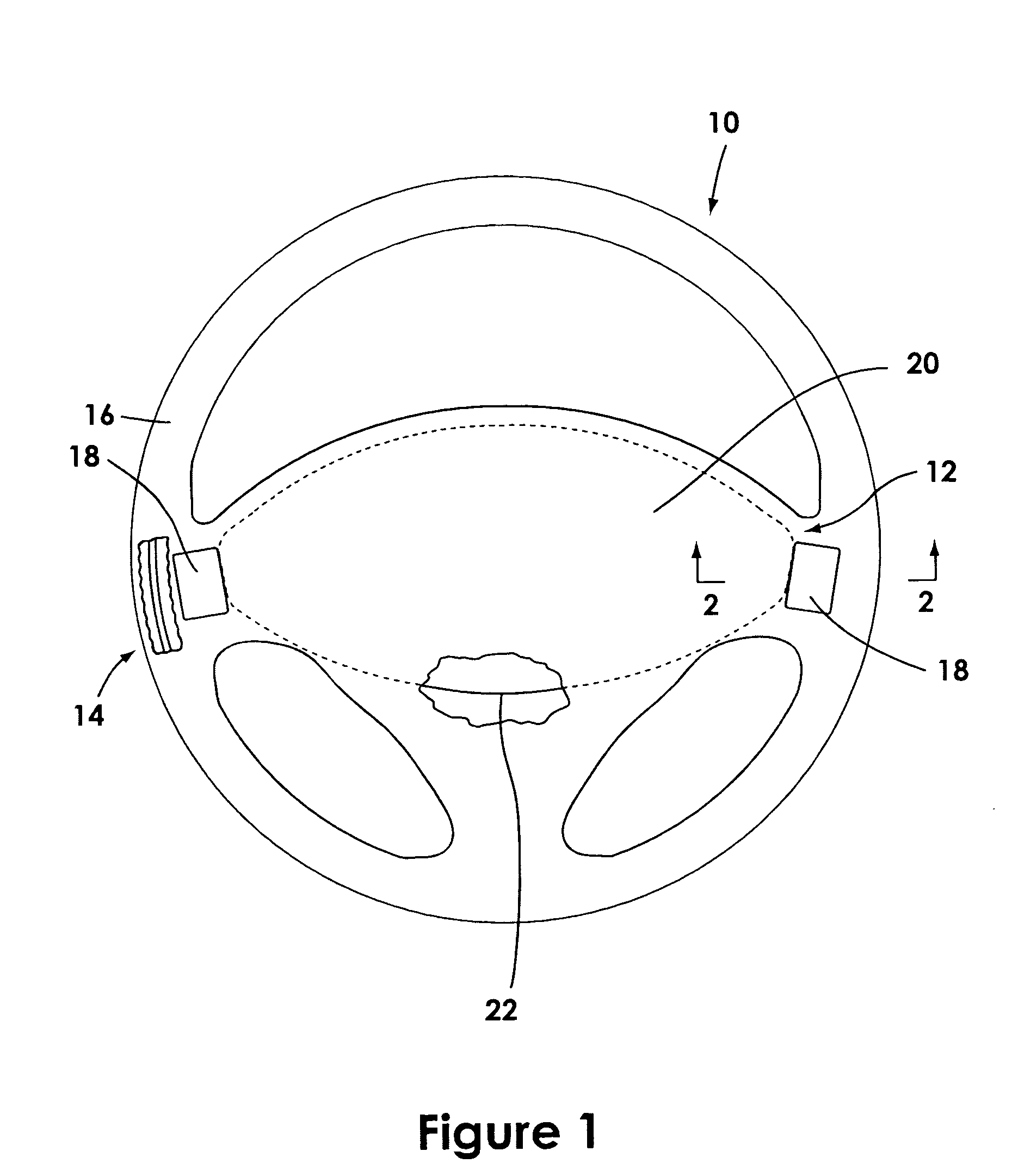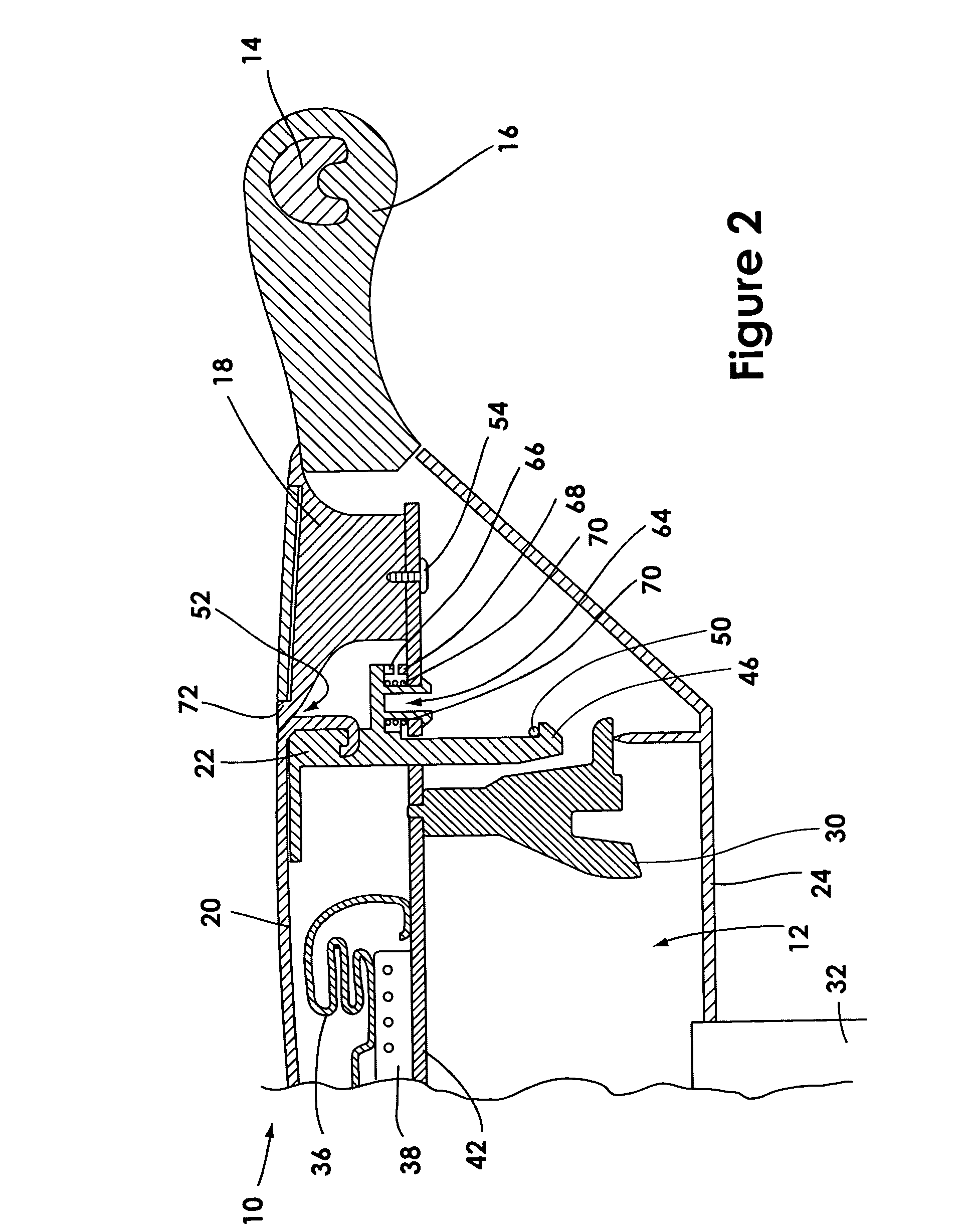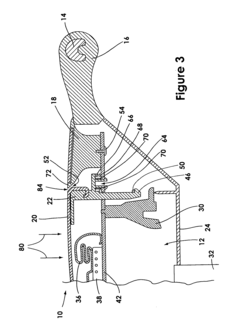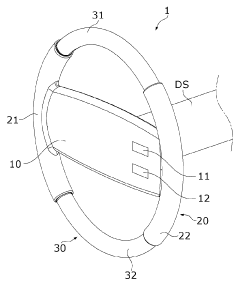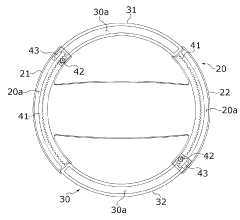How Steering Wheel Trends Influence Global Automotive Design?
JUL 18, 20259 MIN READ
Generate Your Research Report Instantly with AI Agent
Patsnap Eureka helps you evaluate technical feasibility & market potential.
Steering Wheel Evolution and Design Objectives
The steering wheel has undergone significant evolution since its inception in the automotive industry. Initially designed as a simple control mechanism, it has transformed into a multifunctional interface that plays a crucial role in the overall vehicle design and user experience. The primary objective of steering wheel design has always been to provide precise control and maneuverability of the vehicle. However, as automotive technology has advanced, the steering wheel's purpose has expanded to incorporate various functions and features.
In the early days of automobiles, steering wheels were large, often wooden structures designed for maximum leverage and control. As vehicle designs became more streamlined and ergonomic considerations gained importance, steering wheels evolved to become smaller, more comfortable, and easier to handle. The introduction of power steering in the 1950s further influenced steering wheel design, allowing for reduced size and effort required for operation.
The advent of airbag technology in the 1980s marked a significant milestone in steering wheel evolution. Safety became a paramount concern, leading to the integration of airbag modules into the steering wheel hub. This development necessitated a complete redesign of steering wheel structures to accommodate the new safety features while maintaining functionality and aesthetics.
As vehicles became more technologically advanced, the steering wheel transformed into a central control hub. The integration of buttons and switches for various vehicle functions, such as audio controls, cruise control, and communication systems, became standard. This trend towards multifunctionality has continued to shape steering wheel design objectives, with manufacturers striving to balance functionality with simplicity and ease of use.
In recent years, the rise of advanced driver assistance systems (ADAS) and the push towards autonomous vehicles have further influenced steering wheel design objectives. The incorporation of haptic feedback, touch-sensitive surfaces, and even display screens within the steering wheel has become increasingly common. These features aim to enhance driver awareness and provide seamless interaction with the vehicle's advanced systems.
The ongoing shift towards electric and hybrid vehicles has also impacted steering wheel design. With the reduced need for mechanical linkages in these vehicles, designers have more freedom to explore innovative shapes and configurations. This has led to the development of steer-by-wire systems and the exploration of alternative control interfaces, such as joysticks or yoke-style steering wheels.
Looking ahead, the design objectives for steering wheels continue to evolve. Key focus areas include enhancing driver comfort and ergonomics, improving safety features, integrating advanced technologies seamlessly, and adapting to changing vehicle architectures. As the automotive industry moves towards greater electrification and autonomy, steering wheel designs will likely continue to push boundaries, potentially leading to radical departures from traditional circular shapes and functions.
In the early days of automobiles, steering wheels were large, often wooden structures designed for maximum leverage and control. As vehicle designs became more streamlined and ergonomic considerations gained importance, steering wheels evolved to become smaller, more comfortable, and easier to handle. The introduction of power steering in the 1950s further influenced steering wheel design, allowing for reduced size and effort required for operation.
The advent of airbag technology in the 1980s marked a significant milestone in steering wheel evolution. Safety became a paramount concern, leading to the integration of airbag modules into the steering wheel hub. This development necessitated a complete redesign of steering wheel structures to accommodate the new safety features while maintaining functionality and aesthetics.
As vehicles became more technologically advanced, the steering wheel transformed into a central control hub. The integration of buttons and switches for various vehicle functions, such as audio controls, cruise control, and communication systems, became standard. This trend towards multifunctionality has continued to shape steering wheel design objectives, with manufacturers striving to balance functionality with simplicity and ease of use.
In recent years, the rise of advanced driver assistance systems (ADAS) and the push towards autonomous vehicles have further influenced steering wheel design objectives. The incorporation of haptic feedback, touch-sensitive surfaces, and even display screens within the steering wheel has become increasingly common. These features aim to enhance driver awareness and provide seamless interaction with the vehicle's advanced systems.
The ongoing shift towards electric and hybrid vehicles has also impacted steering wheel design. With the reduced need for mechanical linkages in these vehicles, designers have more freedom to explore innovative shapes and configurations. This has led to the development of steer-by-wire systems and the exploration of alternative control interfaces, such as joysticks or yoke-style steering wheels.
Looking ahead, the design objectives for steering wheels continue to evolve. Key focus areas include enhancing driver comfort and ergonomics, improving safety features, integrating advanced technologies seamlessly, and adapting to changing vehicle architectures. As the automotive industry moves towards greater electrification and autonomy, steering wheel designs will likely continue to push boundaries, potentially leading to radical departures from traditional circular shapes and functions.
Market Demand for Advanced Steering Systems
The global automotive industry is witnessing a significant shift in steering wheel design, driven by increasing consumer demand for advanced steering systems. This trend is reshaping the automotive landscape, with manufacturers focusing on developing innovative steering solutions that enhance both functionality and aesthetics.
Market research indicates a growing preference for steering wheels equipped with advanced features such as integrated controls, haptic feedback, and customizable displays. These technologies not only improve driver convenience but also contribute to overall vehicle safety. The demand for such systems is particularly strong in luxury and high-end vehicle segments, where consumers are willing to pay a premium for cutting-edge technology and enhanced driving experiences.
Another key factor driving market demand is the increasing focus on autonomous and semi-autonomous vehicles. As these technologies continue to evolve, steering wheels are being reimagined to accommodate both manual and autonomous driving modes. This has led to the development of retractable steering wheels and adaptive designs that can transition seamlessly between different driving modes.
Environmental concerns and the push for sustainability are also influencing steering wheel trends. There is a growing demand for eco-friendly materials in steering wheel construction, with manufacturers exploring alternatives to traditional leather and plastic components. This shift aligns with broader automotive industry trends towards sustainability and appeals to environmentally conscious consumers.
The integration of biometric sensors in steering wheels is another emerging trend that is gaining traction in the market. These sensors can monitor driver health and alertness, contributing to improved safety features. This technology is particularly appealing in commercial vehicle sectors, where driver fatigue is a significant concern.
Geographically, the demand for advanced steering systems varies. Developed markets such as North America and Europe show a strong appetite for high-tech steering solutions, driven by stringent safety regulations and consumer preferences for luxury features. In contrast, emerging markets are seeing a gradual increase in demand, primarily in urban areas and among higher-income consumers.
The COVID-19 pandemic has also influenced market dynamics, with an increased focus on hygiene and contactless technologies. This has led to a rise in demand for antimicrobial coatings on steering wheels and the development of gesture-controlled systems that minimize physical contact.
As vehicle electrification continues to gain momentum, there is a growing demand for steering systems that are compatible with electric powertrains. These systems often require different design considerations compared to traditional hydraulic steering systems, presenting both challenges and opportunities for manufacturers in the automotive industry.
Market research indicates a growing preference for steering wheels equipped with advanced features such as integrated controls, haptic feedback, and customizable displays. These technologies not only improve driver convenience but also contribute to overall vehicle safety. The demand for such systems is particularly strong in luxury and high-end vehicle segments, where consumers are willing to pay a premium for cutting-edge technology and enhanced driving experiences.
Another key factor driving market demand is the increasing focus on autonomous and semi-autonomous vehicles. As these technologies continue to evolve, steering wheels are being reimagined to accommodate both manual and autonomous driving modes. This has led to the development of retractable steering wheels and adaptive designs that can transition seamlessly between different driving modes.
Environmental concerns and the push for sustainability are also influencing steering wheel trends. There is a growing demand for eco-friendly materials in steering wheel construction, with manufacturers exploring alternatives to traditional leather and plastic components. This shift aligns with broader automotive industry trends towards sustainability and appeals to environmentally conscious consumers.
The integration of biometric sensors in steering wheels is another emerging trend that is gaining traction in the market. These sensors can monitor driver health and alertness, contributing to improved safety features. This technology is particularly appealing in commercial vehicle sectors, where driver fatigue is a significant concern.
Geographically, the demand for advanced steering systems varies. Developed markets such as North America and Europe show a strong appetite for high-tech steering solutions, driven by stringent safety regulations and consumer preferences for luxury features. In contrast, emerging markets are seeing a gradual increase in demand, primarily in urban areas and among higher-income consumers.
The COVID-19 pandemic has also influenced market dynamics, with an increased focus on hygiene and contactless technologies. This has led to a rise in demand for antimicrobial coatings on steering wheels and the development of gesture-controlled systems that minimize physical contact.
As vehicle electrification continues to gain momentum, there is a growing demand for steering systems that are compatible with electric powertrains. These systems often require different design considerations compared to traditional hydraulic steering systems, presenting both challenges and opportunities for manufacturers in the automotive industry.
Current Challenges in Steering Wheel Technology
The steering wheel, a critical interface between driver and vehicle, faces several challenges in modern automotive design. One of the primary issues is the integration of advanced driver assistance systems (ADAS) and autonomous driving technologies. As vehicles become more automated, the traditional role of the steering wheel is being questioned, leading to a need for redesign that accommodates both manual and autonomous driving modes.
Another significant challenge is the incorporation of an increasing number of controls and functions into the steering wheel. Modern drivers expect easy access to various vehicle systems, from infotainment to climate control, directly from the steering wheel. This demand for multifunctionality must be balanced with ergonomic considerations and driver safety, as overly complex designs can lead to distraction and reduced driving performance.
The advent of steer-by-wire technology presents both opportunities and challenges. While it allows for greater flexibility in steering wheel design and placement, it also raises concerns about system reliability and the loss of mechanical connection between the steering wheel and the wheels, which some drivers find disconcerting.
Material selection for steering wheels is another area of ongoing challenge. Manufacturers must balance durability, tactile feel, and luxury aesthetics while also considering sustainability and environmental impact. The push for eco-friendly materials that maintain the premium feel expected in high-end vehicles is driving innovation in this area.
Safety regulations and crash test requirements continue to evolve, necessitating constant adaptation in steering wheel design. The integration of airbags and the need for rapid deployment in collision scenarios must be reconciled with the desire for sleeker, more minimalist designs that align with modern interior aesthetics.
The global nature of the automotive industry adds complexity to steering wheel design. Cultural preferences and driving habits vary across regions, requiring manufacturers to create designs that appeal to diverse markets while maintaining brand consistency and meeting universal safety standards.
Lastly, the emergence of new mobility concepts, such as car-sharing and autonomous ride-hailing services, is challenging traditional notions of steering wheel necessity. Designers must consider scenarios where steering wheels may need to be retractable or removable, adding another layer of complexity to their development and integration within the vehicle architecture.
Another significant challenge is the incorporation of an increasing number of controls and functions into the steering wheel. Modern drivers expect easy access to various vehicle systems, from infotainment to climate control, directly from the steering wheel. This demand for multifunctionality must be balanced with ergonomic considerations and driver safety, as overly complex designs can lead to distraction and reduced driving performance.
The advent of steer-by-wire technology presents both opportunities and challenges. While it allows for greater flexibility in steering wheel design and placement, it also raises concerns about system reliability and the loss of mechanical connection between the steering wheel and the wheels, which some drivers find disconcerting.
Material selection for steering wheels is another area of ongoing challenge. Manufacturers must balance durability, tactile feel, and luxury aesthetics while also considering sustainability and environmental impact. The push for eco-friendly materials that maintain the premium feel expected in high-end vehicles is driving innovation in this area.
Safety regulations and crash test requirements continue to evolve, necessitating constant adaptation in steering wheel design. The integration of airbags and the need for rapid deployment in collision scenarios must be reconciled with the desire for sleeker, more minimalist designs that align with modern interior aesthetics.
The global nature of the automotive industry adds complexity to steering wheel design. Cultural preferences and driving habits vary across regions, requiring manufacturers to create designs that appeal to diverse markets while maintaining brand consistency and meeting universal safety standards.
Lastly, the emergence of new mobility concepts, such as car-sharing and autonomous ride-hailing services, is challenging traditional notions of steering wheel necessity. Designers must consider scenarios where steering wheels may need to be retractable or removable, adding another layer of complexity to their development and integration within the vehicle architecture.
Innovative Steering Wheel Solutions
01 Ergonomic design for comfort and control
Steering wheel designs focus on ergonomic features to enhance driver comfort and control. This includes optimizing the shape, size, and grip of the wheel to reduce fatigue during long drives and improve handling. Ergonomic designs may incorporate contoured surfaces, textured materials, and adjustable elements to accommodate different hand sizes and driving positions.- Ergonomic design for comfort and control: Steering wheel designs focus on ergonomic features to enhance driver comfort and control. This includes optimizing the shape, size, and grip of the wheel to reduce fatigue during long drives and improve handling. Ergonomic designs may incorporate contoured surfaces, textured materials, and adjustable elements to accommodate different hand sizes and driving preferences.
- Integration of advanced controls and displays: Modern steering wheel designs incorporate advanced controls and displays to enhance functionality and driver interaction. This includes integrating buttons, switches, and touch-sensitive surfaces for controlling various vehicle systems such as audio, climate, and navigation. Some designs feature embedded displays or head-up display projections to provide essential information without requiring the driver to look away from the road.
- Safety features and airbag integration: Steering wheel designs prioritize safety by incorporating airbag systems and other protective features. This includes optimizing the wheel's structure to accommodate airbag deployment while maintaining structural integrity during collisions. Some designs focus on reducing the risk of injury from impact with the steering wheel itself, using energy-absorbing materials and collapsible structures.
- Adjustability and customization options: Steering wheel designs often include adjustability features to accommodate different drivers and preferences. This can include telescoping and tilting mechanisms, as well as memory settings for multiple drivers. Some designs offer customizable elements such as interchangeable grip materials or modular button layouts, allowing drivers to personalize their steering wheel experience.
- Materials and manufacturing techniques: Innovative materials and manufacturing techniques are employed in steering wheel design to improve performance, durability, and aesthetics. This includes the use of lightweight materials such as carbon fiber or advanced polymers to reduce weight while maintaining strength. Some designs incorporate specialized coatings or treatments to enhance grip, resist wear, or provide a premium feel. Advanced manufacturing methods, such as 3D printing or precision molding, are used to create complex shapes and integrate multiple components efficiently.
02 Integration of controls and displays
Modern steering wheel designs incorporate various controls and displays directly on the wheel for easy access and improved safety. This can include buttons for audio controls, cruise control, phone operations, and vehicle information systems. Some designs feature integrated displays or touchscreens to provide real-time information without the need to look away from the road.Expand Specific Solutions03 Advanced safety features
Steering wheel designs now include advanced safety features such as airbag systems and impact-absorbing materials. These designs aim to protect the driver in the event of a collision while maintaining the wheel's primary function. Some designs incorporate sensors to detect the driver's grip and alertness, contributing to overall vehicle safety systems.Expand Specific Solutions04 Adjustability and customization
Steering wheels are designed with adjustability features to accommodate different driver preferences and physical characteristics. This includes telescoping and tilting mechanisms, as well as memory settings for multiple drivers. Some designs offer customizable elements such as interchangeable grips or modular components to personalize the driving experience.Expand Specific Solutions05 Integration with autonomous driving systems
As vehicles move towards autonomous capabilities, steering wheel designs are evolving to accommodate both manual and autonomous driving modes. This includes designs that can retract or transform when not in use, as well as systems that provide haptic feedback to signal the transition between driving modes. These designs aim to balance traditional control with future automotive technologies.Expand Specific Solutions
Key Automotive Steering System Manufacturers
The steering wheel industry is in a transformative phase, driven by technological advancements and changing automotive design trends. The market is experiencing steady growth, with a projected global size of $34 billion by 2025. Technological maturity varies across companies, with established players like Autoliv, Tesla, and BMW leading in innovation. Emerging companies such as Geely and Chery are rapidly advancing, particularly in electric and autonomous vehicle integration. The competitive landscape is diverse, with traditional automotive giants like Mercedes-Benz and Honda competing alongside specialized safety system providers like Joyson Safety Systems. This dynamic environment is fostering collaborations and pushing boundaries in steering wheel design, functionality, and integration with advanced driver assistance systems.
Tesla, Inc.
Technical Solution: Tesla has been at the forefront of steering wheel innovation, particularly with their yoke-style steering wheel introduced in the Model S Plaid. This design eliminates the top portion of the traditional wheel, offering a clearer view of the instrument cluster and a more futuristic aesthetic. Tesla's approach integrates advanced driver assistance systems (ADAS) with the steering wheel, incorporating touch-sensitive buttons for turn signals and gear selection[1]. The company has also patented a steering wheel with force-sensing capability, which could potentially detect driver alertness and readiness to take control in semi-autonomous driving scenarios[2]. Tesla's steering wheels are designed to work seamlessly with their Autopilot system, emphasizing the transition between manual and assisted driving modes.
Strengths: Innovative design, integration with ADAS, enhanced visibility. Weaknesses: Potential learning curve for users, limited tactile feedback compared to traditional wheels.
Bayerische Motoren Werke AG
Technical Solution: BMW has been developing steering wheel technologies that focus on enhancing both functionality and luxury. Their latest steering wheels incorporate haptic feedback systems and touch-sensitive controls, allowing drivers to manage various vehicle functions without taking their hands off the wheel[3]. BMW's iDrive controller, often integrated into the steering wheel design, provides a centralized interface for navigation, entertainment, and vehicle settings. The company has also explored the use of LED light strips embedded in the steering wheel rim to provide visual cues for driver assistance systems and autonomous driving modes[4]. In terms of materials, BMW employs high-quality leather and sustainable alternatives, addressing both premium feel and environmental concerns. Their steering wheels are designed to complement the overall interior aesthetics while maintaining ergonomic efficiency.
Strengths: High-end materials, integrated technology, ergonomic design. Weaknesses: Complexity may overwhelm some users, potentially high replacement costs.
Breakthrough Technologies in Steering Systems
Steering wheel assembly
PatentInactiveUS20050012310A1
Innovation
- A steering wheel design that eliminates the gap between the airbag cover and the intermediate portion by using an overhanging intermediate portion or a shingle with a flex point, ensuring no gap forms when the upper housing is in the normal position, and allowing a gap to form when depressed, thus maintaining aesthetic appeal and functionality.
Vehicle steering wheel
PatentPendingKR1020240035007A
Innovation
- A variable steering wheel design featuring a wheel base, fixed rims with storage spaces, and a driving mechanism using rack and pinion gears to adjust the shape between stored and extended modes, allowing drivers to select their preferred configuration.
Regulatory Framework for Steering Systems
The regulatory framework for steering systems plays a crucial role in shaping global automotive design trends, particularly in relation to steering wheels. These regulations are primarily focused on ensuring safety, reliability, and performance standards across different regions and markets.
In the United States, the National Highway Traffic Safety Administration (NHTSA) sets forth Federal Motor Vehicle Safety Standards (FMVSS) that directly impact steering system design. FMVSS 203 and 204 specifically address occupant protection in steering control systems, influencing the design and materials used in steering wheels. These standards have led to the widespread adoption of energy-absorbing steering columns and airbag integration in steering wheels.
The European Union's regulatory framework, governed by the United Nations Economic Commission for Europe (UNECE), has similar safety requirements. Regulation No. 12 deals with the protection of drivers against the steering mechanism in the event of impact. This has resulted in the development of collapsible steering columns and deformable steering wheels, which have become standard features in modern vehicles.
In recent years, regulations have begun to address advanced driver assistance systems (ADAS) and autonomous driving technologies. These emerging regulations are influencing the design of steering wheels to incorporate new functionalities, such as hands-on detection sensors and integrated controls for ADAS features.
The global push for vehicle electrification has also impacted steering system regulations. With the rise of electric power steering (EPS) systems, regulatory bodies have had to adapt their standards to ensure these systems meet safety and performance criteria. This shift has allowed for more compact and energy-efficient steering designs, influencing the overall layout of vehicle interiors.
Regulatory frameworks are also evolving to accommodate innovative steering concepts, such as steer-by-wire systems. These technologies, which eliminate the physical connection between the steering wheel and the wheels, require new safety protocols and redundancy measures to gain regulatory approval.
As vehicle automation advances, regulations are being developed to address the potential for steering wheels to become optional or removable in fully autonomous vehicles. This regulatory shift is prompting automotive designers to reconsider the role and placement of steering controls in future vehicle concepts.
The harmonization of global regulations through initiatives like the 1998 Agreement on Global Technical Regulations is streamlining the regulatory landscape for steering systems. This international cooperation is facilitating the development of steering technologies that can be more easily adopted across different markets, potentially accelerating innovation in steering wheel design.
In the United States, the National Highway Traffic Safety Administration (NHTSA) sets forth Federal Motor Vehicle Safety Standards (FMVSS) that directly impact steering system design. FMVSS 203 and 204 specifically address occupant protection in steering control systems, influencing the design and materials used in steering wheels. These standards have led to the widespread adoption of energy-absorbing steering columns and airbag integration in steering wheels.
The European Union's regulatory framework, governed by the United Nations Economic Commission for Europe (UNECE), has similar safety requirements. Regulation No. 12 deals with the protection of drivers against the steering mechanism in the event of impact. This has resulted in the development of collapsible steering columns and deformable steering wheels, which have become standard features in modern vehicles.
In recent years, regulations have begun to address advanced driver assistance systems (ADAS) and autonomous driving technologies. These emerging regulations are influencing the design of steering wheels to incorporate new functionalities, such as hands-on detection sensors and integrated controls for ADAS features.
The global push for vehicle electrification has also impacted steering system regulations. With the rise of electric power steering (EPS) systems, regulatory bodies have had to adapt their standards to ensure these systems meet safety and performance criteria. This shift has allowed for more compact and energy-efficient steering designs, influencing the overall layout of vehicle interiors.
Regulatory frameworks are also evolving to accommodate innovative steering concepts, such as steer-by-wire systems. These technologies, which eliminate the physical connection between the steering wheel and the wheels, require new safety protocols and redundancy measures to gain regulatory approval.
As vehicle automation advances, regulations are being developed to address the potential for steering wheels to become optional or removable in fully autonomous vehicles. This regulatory shift is prompting automotive designers to reconsider the role and placement of steering controls in future vehicle concepts.
The harmonization of global regulations through initiatives like the 1998 Agreement on Global Technical Regulations is streamlining the regulatory landscape for steering systems. This international cooperation is facilitating the development of steering technologies that can be more easily adopted across different markets, potentially accelerating innovation in steering wheel design.
Ergonomics and Human-Machine Interface in Steering Design
The ergonomics and human-machine interface (HMI) in steering design play a crucial role in shaping global automotive design trends. As vehicles become more technologically advanced, the steering wheel has evolved from a simple control device to a sophisticated interface between the driver and the vehicle's systems.
Ergonomic considerations in steering wheel design focus on optimizing driver comfort, control, and safety. Manufacturers are increasingly adopting adjustable steering columns and telescopic steering wheels to accommodate a wider range of driver sizes and preferences. The shape and contour of steering wheels are being refined to reduce driver fatigue during long journeys, with emphasis on grip comfort and hand positioning.
The integration of HMI elements into steering wheels has become a significant trend influencing automotive design globally. Multifunction steering wheels now incorporate controls for various vehicle systems, including audio, communication, and driver assistance features. This integration allows drivers to access essential functions without removing their hands from the wheel, enhancing safety and convenience.
Touch-sensitive surfaces and haptic feedback mechanisms are being incorporated into steering wheel designs, providing a more intuitive and responsive interface. These technologies allow for customizable control layouts and can adapt to different driving modes or user preferences, further personalizing the driving experience.
The advent of autonomous driving technologies is also influencing steering wheel design. Concepts for retractable or foldable steering wheels are being explored to maximize interior space when the vehicle is in autonomous mode. This trend is pushing designers to rethink the entire dashboard and cockpit layout, potentially revolutionizing the traditional automotive interior design paradigm.
As vehicle electrification gains momentum, steering wheel design is adapting to accommodate new powertrain characteristics. Electric power steering systems allow for more flexibility in steering feel and responsiveness, which can be tailored to different driving conditions or driver preferences through software adjustments.
The global push for improved safety has led to the integration of advanced driver monitoring systems within steering wheels. Sensors embedded in the wheel can detect driver grip, alertness, and even health parameters, contributing to the overall safety ecosystem of modern vehicles.
In conclusion, the ergonomics and HMI aspects of steering design are at the forefront of automotive innovation, driving changes in vehicle interiors, safety systems, and overall user experience. As these trends continue to evolve, they will significantly influence global automotive design, shaping the future of human-vehicle interaction.
Ergonomic considerations in steering wheel design focus on optimizing driver comfort, control, and safety. Manufacturers are increasingly adopting adjustable steering columns and telescopic steering wheels to accommodate a wider range of driver sizes and preferences. The shape and contour of steering wheels are being refined to reduce driver fatigue during long journeys, with emphasis on grip comfort and hand positioning.
The integration of HMI elements into steering wheels has become a significant trend influencing automotive design globally. Multifunction steering wheels now incorporate controls for various vehicle systems, including audio, communication, and driver assistance features. This integration allows drivers to access essential functions without removing their hands from the wheel, enhancing safety and convenience.
Touch-sensitive surfaces and haptic feedback mechanisms are being incorporated into steering wheel designs, providing a more intuitive and responsive interface. These technologies allow for customizable control layouts and can adapt to different driving modes or user preferences, further personalizing the driving experience.
The advent of autonomous driving technologies is also influencing steering wheel design. Concepts for retractable or foldable steering wheels are being explored to maximize interior space when the vehicle is in autonomous mode. This trend is pushing designers to rethink the entire dashboard and cockpit layout, potentially revolutionizing the traditional automotive interior design paradigm.
As vehicle electrification gains momentum, steering wheel design is adapting to accommodate new powertrain characteristics. Electric power steering systems allow for more flexibility in steering feel and responsiveness, which can be tailored to different driving conditions or driver preferences through software adjustments.
The global push for improved safety has led to the integration of advanced driver monitoring systems within steering wheels. Sensors embedded in the wheel can detect driver grip, alertness, and even health parameters, contributing to the overall safety ecosystem of modern vehicles.
In conclusion, the ergonomics and HMI aspects of steering design are at the forefront of automotive innovation, driving changes in vehicle interiors, safety systems, and overall user experience. As these trends continue to evolve, they will significantly influence global automotive design, shaping the future of human-vehicle interaction.
Unlock deeper insights with Patsnap Eureka Quick Research — get a full tech report to explore trends and direct your research. Try now!
Generate Your Research Report Instantly with AI Agent
Supercharge your innovation with Patsnap Eureka AI Agent Platform!
